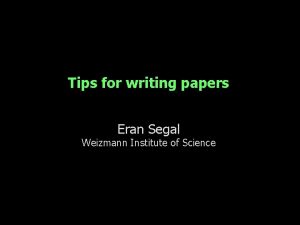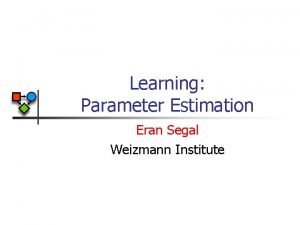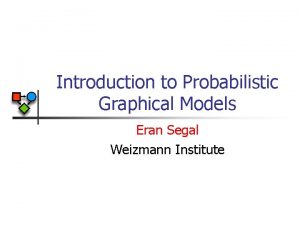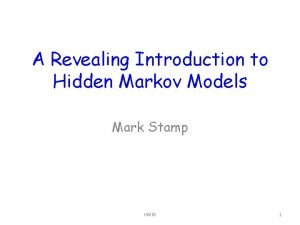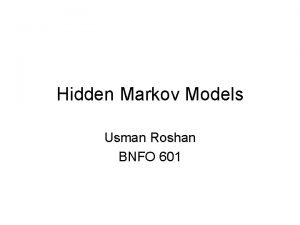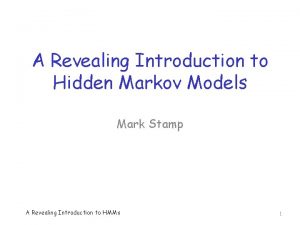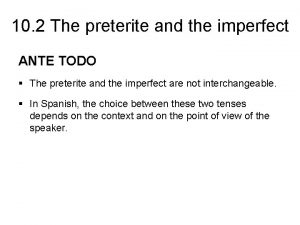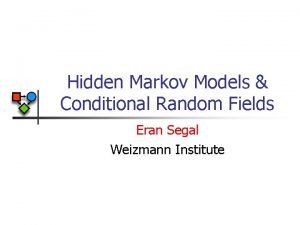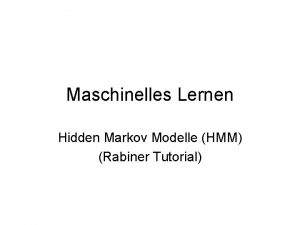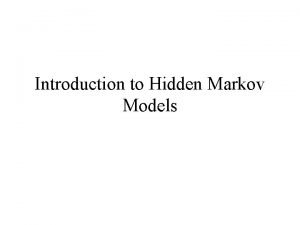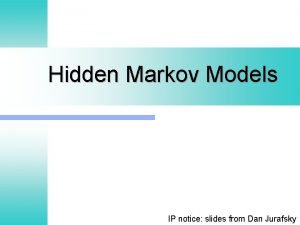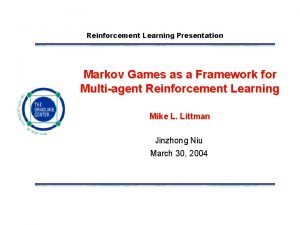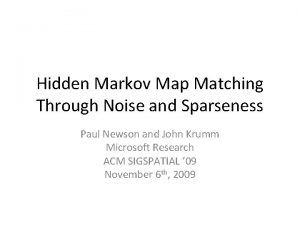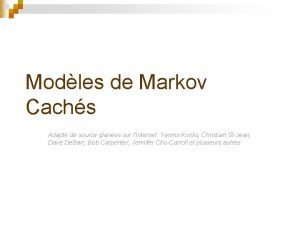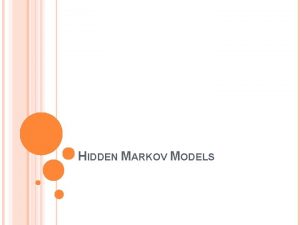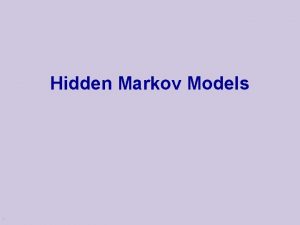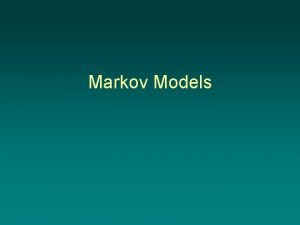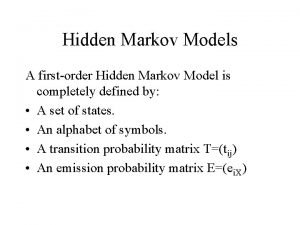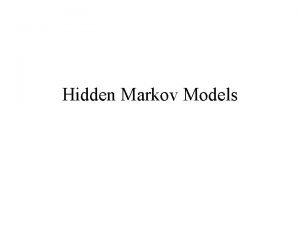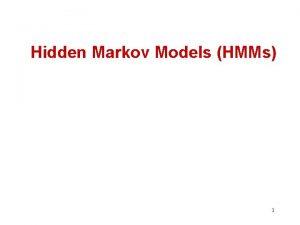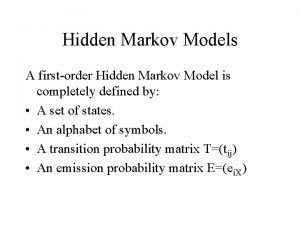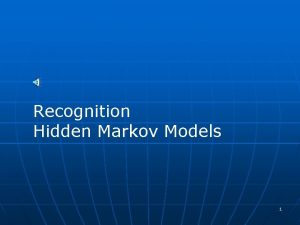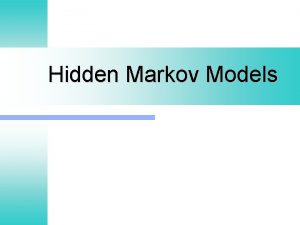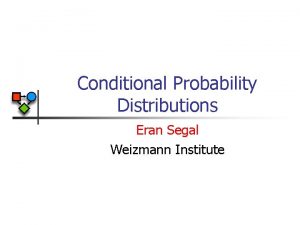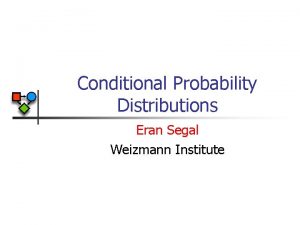Hidden Markov Models Conditional Random Fields Eran Segal
















- Slides: 16

Hidden Markov Models & Conditional Random Fields Eran Segal Weizmann Institute

Representing Time n n Add the time dimension to variables X X(t) Assumptions n Time can be discretized into interesting points t 1, t 2, . . . tn n Markov assumption holds n Distribution is stationary (time invariant or homogeneous)

Hidden Markov Model n n n Single (hidden) state variable Single (observed) observation variable Transition probability P(Y’|Y) assumed to be sparse n n Usually encoded by a state transition graph Observation probability P(X|Y) Y G Y’ Y 0 X’ X 0 G 0 Y 1 Y 2 Y 3 X 1 X 2 X 3 Unrolled network

Hidden Markov Model n n n Single (hidden) state variable Single (observed) observation variable Transition probability P(Y’|Y) assumed to be sparse n n Usually encoded by a state transition graph Observation probability P(X|Y) P(Y’|Y) Y 1 Y 2 Y 3 Y 4 State transition representation y 1 y 2 y 3 y 4 y 1 0. 2 0. 8 0 0 y 2 0 0 1 0 y 3 0. 4 0 0 0. 6 y 4 0 0. 5

Hidden Markov Models n Generative models n n n Assign a joint probability to paired label and observation Parameters trained to maximize train joint likelihood To make inference tractable, there are typically no long-range dependencies Y 0 Y 1 Y 2 Y 3 X 1 X 2 X 3 Unrolled network

Conditional Models n n n Specifies the probability of possible label sequences given the observations, P(Y|X) Does not “waste” parameters on modeling P(X|Y) Key advantage: n n n Distribution over Y can depend on non-independent features without modeling feature dependencies Transition probabilities can depend on past and future Two representations n n Maximum Entropy Markov Models (MEMMs) Conditional Random Fields (CRFs)

Max Entropy Markov Models n n n Models the probability over the next state given the previous state and the observations Training is by iterative scaling in the maximum entropy framework Weakness: label bias problem Y 0 Y 1 Y 2 Y 3 X 1 X 2 X 3 HMM Y 0 Y 1 Y 2 Y 3 X 1 X 2 X 3 MEMM

Label-Bias Problem of MEMMs n Transitions from a state compete only with each other n n Transition scores are conditional probabilities of next states given current state and observation This implies a “conservation of score mass” whereby mass of a state is distributed among next states Observations do not affect the total mass of next states Biases for states with fewer outgoing transitions n n States with a single outgoing transition ignore observations Unlike HMMs, observations after a branch point in a path are ignored

Label-Bias Problem: Example n n A model for distinguishing ‘rob’ from ‘rib’ Suppose we get an input sequence ‘rib’ n n First step, ‘r’ matches both possible states so equally likely Next, ‘i’ is observed, but since both y 1 and y 4 have one outgoing state, they both give probability 1 to the next state Does not happen in HMMs Note: if one word is more likely in train it will win r y 1 i P(Y’|Y) y 2 b y 0 y 3 r y 4 o y 5 b State transition representation y 0 y 1 y 2 y 3 y 4 y 5 y 0 0 0. 5 0 0 0 y 1 0 0 0 y 2 0 0 0 1 0 0 y 3 0 0 0 1 0 0 y 4 0 0 0 1 y 5 0 0 0 1 0 0

Conditional Random Fields n n Advantages of MEMMs without the label bias problem Key difference n n MEMMs use per-state model for conditional probabilities of next state given current state CRFs have a single model for the joint probability of the entire sequence of labels given the observations n n Thus, weights of different features at different states can trade off against each other CRF training n n Maximum likelihood or MAP Loss function is convex, guaranteeing convergence to global optimum

Conditional Random Fields n n Let G=(V, E) be a graph with vertices V and edges E, such that Then (X, Y) is a CRF if the random variables Yv obey the Markov property with respect to the graph: n n where Yj is the set of Y neighbors of Yi Model only P(Y|X) Y 0 Y 1 Y 2 Y 3 X 1 X 2 X 3 CRF

Conditional Random Fields n Joint probability distribution for trees over Y n n n n Cliques (and thus potentials) are the edges and vertices x are the observed variables y are the state variables y[S] is the components of Y associated with vertices in S fk is an edge feature with weight λk gk is a vertex feature with weight μk Note that features can be over all of variables in x

Representing HMMs with CRFs n An HMM can be represented by the following CRF n n where Note that we defined one feature for each state pair (y’, y) and one feature for each state-observation pair (y, x)

Parameter Estimation

Applications

Conditional Random Fields n Joint probability distribution for trees over Y n Cliques (and thus potentials) are the edges and vertices
 Eran segal
Eran segal Eran segal
Eran segal Eran segal
Eran segal A revealing introduction to hidden markov models
A revealing introduction to hidden markov models Hidden markov models
Hidden markov models A revealing introduction to hidden markov models
A revealing introduction to hidden markov models Intentalo eran las doce
Intentalo eran las doce Eran fields
Eran fields Hidden markov model
Hidden markov model Rabiner hmm
Rabiner hmm Hidden markov chain
Hidden markov chain Hidden markov chain
Hidden markov chain Hidden markov chain
Hidden markov chain Hidden markov model rock paper scissors
Hidden markov model rock paper scissors Hidden markov map matching through noise and sparseness
Hidden markov map matching through noise and sparseness Hidden markov model tutorial
Hidden markov model tutorial Red fields to green fields
Red fields to green fields
